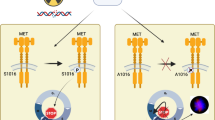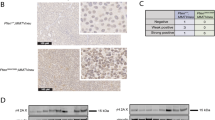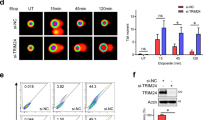Abstract
H4(D10S170) gene has been identified upon its frequent rearrangement with RET in papillary thyroid tumours (RET/PTC1). The kinase ataxia telangectasia mutated (ATM) phosphorylates a limited number of downstream protein targets in response to DNA damage. We investigated the potential role of H4(D10S170) in DNA damage signaling pathways. We found that in cells treated with etoposide or ionizing radiation (IR), H4(D10S170) underwent ATM-mediated phosphorylation at Thr 434, stabilizing nuclear H4. In ataxia telangectasia cells (A-T), endogenous H4(D10S170) was localized to cytoplasm and was excluded from the nucleus. Moreover, H4(D10S170) was not phosphorylated in ATM-deficient lymphoblasts after ionizing irradiation. Inhibition of ATM kinase interfered with H4(D10S170) apoptotic activity, and expression of H4 with threonine 434 mutated in Alanine, H4T434A, protected the cells from genotoxic stress-induced apoptosis. Most importantly, after exposure to IR we found that silencing of H4(D10S170) in mammalian cells increased cell survival, as shown by clonogenic assay, allows for DNA synthesis as evaluated by bromodeoxyuridine incorporation and permits cells to progress into mitosis as demonstrated by phosphorylation on Histone H3. Our results suggest that H4(D10S170) is involved in cellular response to DNA damage ATM-mediated, and that the impairment of H4(D10S170) gene function might have a role in thyroid carcinogenesis.
This is a preview of subscription content, access via your institution
Access options
Subscribe to this journal
Receive 50 print issues and online access
$259.00 per year
only $5.18 per issue
Buy this article
- Purchase on Springer Link
- Instant access to full article PDF
Prices may be subject to local taxes which are calculated during checkout






Similar content being viewed by others
References
Bakkenist CJ, Kastan MB . (2003). DNA damage activates ATM through intermolecular autophosphorylation and dimer dissociation. Nature 421: 499–506.
Canman CE, Lim DS . (1998). The role of ATM in DNA damage responses and cancer. Oncogene 17: 3301–3308.
Caudill CM, Zhu Z, Ciampi R, Stringer JR, Nikiforov YE . (2005). Dose-dependent generation of RET/PTC in human thyroid cells after in vitro exposure to gamma-radiation: a model of carcinogenic chromosomal rearrangement induced by ionizing radiation. J Clin Endocrinol Metab 90: 2364–2369.
Celetti A, Cerrato A, Merolla F, Vitagliano D, Vecchio G, Grieco M . (2004). H4(D10S170), a gene frequently rearranged with RET in papillary thyroid carcinomas: functional characterization. Oncogene 23: 109–121.
DiTullio Jr RA, Mochan TA, Venere M, Bartkova J, Sehested M, Bartek J et al. (2002). 53BP1 functions in an ATM-dependent checkpoint pathway that is constitutively activated in human. Nat Cell Biol cancer 4: 998–1002.
Fusco A, Grieco M, Santoro M, Berlingieri MT, Pilotti S, Pierotti MA et al. (1987). A new oncogene in human thyroid papillary carcinomas and their lymph-nodal metastases. Nature 328: 170–172.
Goodhead DT . (1994). Initial events in the cellular effects of ionizing radiations: clustered damage in DNA. Int J Radiat Biol 65: 7–17.
Grieco M, Cerrato A, Santoro M, Fusco A, Melillo RM, Vecchio G . (1994). Cloning and characterization of H4 (D10S170), a gene involved in RET rearrangements in vivo. Oncogene 9: 2531–2535.
Grieco M, Santoro M, Berlingieri MT, Melillo RM, Donghi R, Bongarzone I et al. (1990). PTC is a novel rearranged form of the ret proto-oncogene and is frequently detected in vivo in human thyroid papillary carcinomas. Cell 60: 557–563.
Hickson I, Zhao Y, Richardson CJ, Green SJ, Martin NM, Orr AI et al. (2004). Identification and characterization of a novel and specific inhibitor of the ataxia-telangiectasia mutated kinase ATM. Cancer Res 64: 9152–9159.
Iliakis G, Wang Y, Guan J, Wang H . (2003). DNA damage checkpoint control in cells exposed to ionizing radiation. Oncogene 22: 5834–5847.
Jhiang SM . (2000). The RET proto-oncogene in human cancers. Oncogene 19: 5590–5597.
Jossart GH, O'Brien B, Cheng JF, Tong Q, Jhiang SM, Duh Q et al. (1996). A novel multicolor hybridization scheme applied to localization of a transcribed sequence (D10S170/H4) and deletion mapping in the thyroid cancer cell line TPC-1. Cytogenet Cell Gene 75: 254–257.
Kastan M, Lim DS . (2000). The many substrates and functions of ATM. Nat Rev Mol Cell Biol 1: 179–186.
Kim ST, Lim DS, Canman CE, Kastan MB . (1999). Substrate specificities and identification of putative substrates of ATM kinase family members. J Biol Chem 274: 37538–37543.
Kulkarni S, Heath C, Parker S, Chase A, Iqbal S, Pocock CF et al. (2000). Fusion of H4/D10S170 to the platelet-derived growth factor receptor beta in BCR-ABL-negative myeloproliferative disorders with a t(5;10)(q33;q21). Cancer Res 60: 3592–3598.
Laemli UK . (1970). Cleavage of structural proteins during the assembly of the head of bacteriophage T4. Nature 227: 680–685.
Lee JH, Paull TT . (2004). Direct activation of the ATM protein kinase by the Mre11/Rad50/Nbs1 complex. Science 304: 93–96.
Leskov KS, Criswell T, Antonio S, Li J, Yang CR, Kinsella TJ et al. (2001). When X-ray-inducible proteins meet DNA double strand break repair. Semin Radiat Oncol 11: 352–372.
Lim DS, Kim ST, Xu B, Maser RS, Lin J, Petrini JH et al. (2000). ATM phosphorylates p95/nbs1 in an S-phase checkpoint pathway. Nature 404: 613–617.
Little JB . (2003). Genomic instability and bystander effects: a historical perspective. Oncogene 22: 6978–6987.
Motoyama N, Naka K . (2004). DNA damage tumor suppressor genes and genomic instability. Curr Opin Genet Dev 14: 11–16.
Nikiforova MN, Ciampi R, Salvatore G, Santoro M, Gandhi M, Knauf JA et al. (2004). Low prevalence of BRAF mutations in radiation-induced thyroid tumors in contrast to sporadic papillary carcinomas. Cancer Lett 209: 1–6.
Nikiforova MN, Stringer JR, Blough R, Medvedovic M, Fagin JA, Nikiforov YE . (2000). Proximity of chromosomal loci that participate in radiation-induced rearrangements in human cells. Science 290: 138–141.
Obenauer JC, Cantley LC, Yaffe MB . (2003). Scansite 2.0: Proteome-wide prediction of cell signaling interactions using short sequence motifs. Nucleic Acids Res 31: 3635–3641.
O'Neill T, Dwyer AJ, Ziv Y, Chan DW, Lees-Miller SP, Abraham RH et al. (2000). Utilization of oriented peptide libraries to identify substrate motifs selected by ATM. J Biol Chem 275: 22719–22727.
Penserga ET, Skorski T . (2007). Fusion tyrosine kinases: a result and cause of genomic instability. Oncogene 26: 11–20.
Pierotti MA, Santoro M, Jenkins RB, Sozzi G, Bongarzone I, Grieco M . (1992). Characterization of an inversion on the long arm of chromosome 10 juxtaposing D10S170 and RET and creating the oncogenic sequence RET/PTC. Proc Natl Acad Sci USA 89: 1616–1620.
Puxeddu E, Zhao G, Stringer JR, Medvedovic M, Moretti S, Fagin JA . (2005). Characterization of novel non-clonal intrachromosomal rearrangements between the H4 and PTEN genes (H4/PTEN) in human thyroid cell lines and papillary thyroid cancer specimens. Mutat Res 570: 17–32.
Radivoyevitch T, Sachs RK, Nikiforov YE, Nikiforova MN, Little MP . (2001). On target cell numbers in radiation-induced H4-RET mediated papillary thyroid cancer. Radiat Environ Biophys 40: 191–197.
Ron E, Lubin JH, Shore RE, Mabuchi K, Modan B, Pottern LM et al. (1995). On target cell numbers in radiation-induced H4-RET mediated papillary thyroid cancer. Radiat Res 141: 259–277.
Schwaller J, Anastasiadou E, Cain D, Kutok J, Wojiski S, Williams IR et al. (2001). H4(D10S170), a gene frequently rearranged in papillary thyroid carcinoma, is fused to the platelet-derived growth factor receptor beta gene in atypical chronic myeloid leukemia with t(5;10)(q33;q22). Blood 97: 3910–3918.
Sheils OM, O'Leary JJ, Sweeney EC . (2000). Assessment of ret/PTC-1 rearrangements in neoplastic thyroid tissue using TaqMan RT–PCR. J Pathol 192: 32–36.
Shiloh Y . (2003). ATM: ready, set, go. Cell Cycle 2: 116–117.
Smith LE, Nagar S, Kim GJ, Morgan WF . (2003). Radiation-induced genomic instability: radiation quality and dose response. Health Phys 85: 23–29.
Tong Q, Xing S, Jhiang SM . (1997). Leucine zipper-mediated dimerization is essential for the PTC1 oncogenic activity. J Biol Chem 272: 9043–9047.
Towbin H, Staehelin T, Gordon J . (1979). Electrophoretic transfer of proteins from polyacrylamide gels to nitrocellulose sheets: procedure and some applications. Proc Natl Acad Sci USA 76: 4350–4354.
Ward JF . (1995). Radiation mutagenesis: the initial DNA lesions responsible. Radiat Res 142: 362–368.
Acknowledgements
We are grateful to Massimo Santoro for helpful discussion and encouragements. We are indebted to Tommaso Russo for critical remarks and suggestions. This study was supported by grants from the Associazione Italiana per la Ricerca sul Cancro (AIRC).
Author information
Authors and Affiliations
Corresponding author
Additional information
Supplementary Information accompanies the paper on the Oncogene website (http://www.nature.com/onc).
Rights and permissions
About this article
Cite this article
Merolla, F., Pentimalli, F., Pacelli, R. et al. Involvement of H4(D10S170) protein in ATM-dependent response to DNA damage. Oncogene 26, 6167–6175 (2007). https://doi.org/10.1038/sj.onc.1210446
Received:
Revised:
Accepted:
Published:
Issue Date:
DOI: https://doi.org/10.1038/sj.onc.1210446



